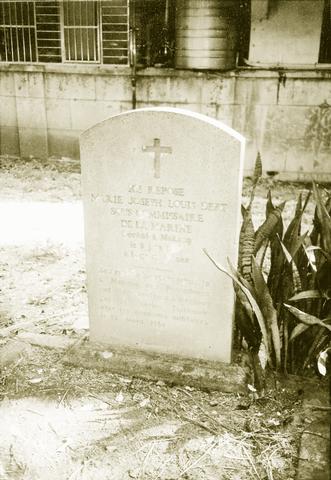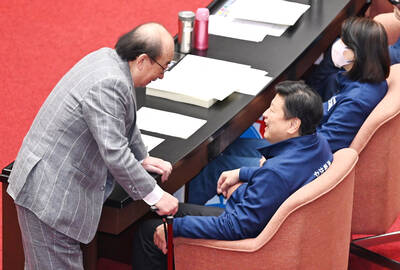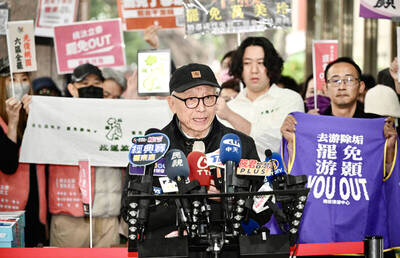Keelung has a long history of contact with the West -- at various times the port has hosted a Spanish garrison, a Dutch trading post, and a British consulate -- but many visitors overlook the port's French cemetery, a relic of the Sino-French War of 1884 to 1885 located on a city plot hemmed in by buildings near the ruins of Ershawan Fort (
Part of the significance of this graveyard lies in it being the largest concentration of foreign remains in Taiwan, with the exception of Taichung City's Paochueh Temple (寶覺寺), where the bones of Japanese nationals who died during the colonial period were reburied after World War II.

PHOTO: STEVEN CROOK
The French cemetery is the subject of a new book by Christophe Rouil titled Formosa: Some Nearly-Forgotten Battles, which took the author a year and a half to research and write. The French-language edition will be launched at the end of this month. English and Chinese-language versions will appear next year.
With the help of the Social Affairs Bureau, Rouil collected information from the archives of the French armed forces and diplomatic corps, and visited Makung in the Penghu Islands, where the leader of the French expedition, Admiral Amedee Courbet, died of a tropical disease in June 1885.
Battle a `minor detail'
Courbet is regarded as one of France's heroes because of his military exploits in the 1860s, but neither the war in which he died nor the fate of the Keelung French cemetery are well known in France.
"History books treat the Sino-French War as a minor detail in the history of France's colonization of Indochina," Rouil says. France attacked Taiwan in 1884 because of a dispute with the Ching (
The current French cemetery is not the original, Rouil explains. The remains were moved there from a seaside location in 1909.
The graveyard -- which is not much bigger than a tennis court and is shaded by a canopy of trees -- has been looked after by the Keelung City Government in recent years. Unlike the foreigners' cemetery in Tamsui, the site has not been designated a national relic, but it is open to the public.
Near-identical obelisks stand at opposite ends of the plot -- one in French is dedicated to soldiers and sailors; the other, in both French and Chinese, is dedicated to officers as well. A few other markers are too weathered to read. One standing over a mass grave reads: "Here lay the soldiers and sailors of France who died in Keelung."
The number of French servicemen buried here is unknown, according to Rouil, though, neither the often-cited figure of 500, nor the 700 inscribed on the graveyard's memorial stone are accurate. His research indicates that the remains of around 600 French officers, soldiers, and sailors lie in the Keelung French Cemetery. Approximately 120 of them were killed in battle, while 150 died later of their wounds. The majority succumbed to malaria, cholera, dysentery, or other maladies. More than a fifth of the French force never returned home.
Archibald R. Colquhoun, a British political commentator who visited Keelung during France's eight-month-long occupation, and J.H. Stewart-Lockhart, described the decimation of the French forces in an 1885 issue of The China Review: "The French no sooner landed in Keelung than they began to experience what the climate of Formosa is for the European. The small force under Admiral Courbet has been greatly weakened by sickness, a considerable number of men being sent away by each French mail steamer, calling fortnightly at Keelung, as well as by each available transport."
It seems, however, that everyone was vulnerable to the hot, unsanitary conditions prevailing in 19th-century Taiwan. Some historians have attributed the Ching dynasty's weak control over the island to the pestilential climate, which kept Mandarins away and demoralized army units charged with expanding the area under Han Chinese control. An 1874 Japanese punitive expedition lost 500 men to malaria; and when the Japanese returned in 1895 to colonize Taiwan, half of their soldiers died within weeks.
According to the soon-to-be-published diaries of the Reverend George Mackay, several deserters from the French Foreign Legion turned up in Tamsui, which French warships had shelled and blockaded en route to Keelung.
In From Far Formosa, Mackay writes that some seven Presbyterian churches were destroyed by angry mobs and numerous Christians were beaten, at least two of whom died of their wounds.
In 1889, 1891, 1895 and 1901 the Keelung French Cemetery was tidied up by sailors from French warships dropping anchor nearby. In 1890 France entered into a maintenance agreement with the Ching authorities; a similar arrangement with Japan ensured that the graveyard was looked after during the 1895-1945 colonial period.
After World War II the cemetery fell into disrepair. In 1947, M. Bayens, a French diplomat based in Shanghai, reported to his superiors that the graveyard was in a terrible state. Rather than wait for instructions from Paris, he spent around US$100 of his own money (which was later reimbursed by France's foreign ministry) to have the cemetery fixed up, Rouil says.
Voyage of no return
After leaving Keelung, the French flotilla sailed for Penghu. Admiral Courbet was not the only member of the expedition to die there. Two officers and several other enlisted men also fell victim to disease.
Courbet's body was taken back to France and accorded a state funeral on Sept. 1, 1885. He is buried in Abbeville in northern France, his hometown. The two officers were disinterred in 1954 and reburied, with new headstones, in the Keelung French Cemetery.
The soil at the original burial site was carefully sieved so that every tooth and bone could be retrieved and the skeletons reassembled, Rouil recounts in his book. The exhumation process was complicated by local superstitions. To placate possibly troublesome spirits, salt was scattered over the plot, incantations chanted, "and the local people insisted on hiding the skulls from the sun with red paper," says Rouil.
French expatriates in Taiwan visit the cemetery three times a year in May, July and November to place flowers on the graves and hold memorial services.

Feb. 17 to Feb. 23 “Japanese city is bombed,” screamed the banner in bold capital letters spanning the front page of the US daily New Castle News on Feb. 24, 1938. This was big news across the globe, as Japan had not been bombarded since Western forces attacked Shimonoseki in 1864. “Numerous Japanese citizens were killed and injured today when eight Chinese planes bombed Taihoku, capital of Formosa, and other nearby cities in the first Chinese air raid anywhere in the Japanese empire,” the subhead clarified. The target was the Matsuyama Airfield (today’s Songshan Airport in Taipei), which

On Jan. 17, Beijing announced that it would allow residents of Shanghai and Fujian Province to visit Taiwan. The two sides are still working out the details. President William Lai (賴清德) has been promoting cross-strait tourism, perhaps to soften the People’s Republic of China’s (PRC) attitudes, perhaps as a sop to international and local opinion leaders. Likely the latter, since many observers understand that the twin drivers of cross-strait tourism — the belief that Chinese tourists will bring money into Taiwan, and the belief that tourism will create better relations — are both false. CHINESE TOURISM PIPE DREAM Back in July

Could Taiwan’s democracy be at risk? There is a lot of apocalyptic commentary right now suggesting that this is the case, but it is always a conspiracy by the other guys — our side is firmly on the side of protecting democracy and always has been, unlike them! The situation is nowhere near that bleak — yet. The concern is that the power struggle between the opposition Chinese Nationalist Party (KMT) and their now effectively pan-blue allies the Taiwan People’s Party (TPP) and the ruling Democratic Progressive Party (DPP) intensifies to the point where democratic functions start to break down. Both

This was not supposed to be an election year. The local media is billing it as the “2025 great recall era” (2025大罷免時代) or the “2025 great recall wave” (2025大罷免潮), with many now just shortening it to “great recall.” As of this writing the number of campaigns that have submitted the requisite one percent of eligible voters signatures in legislative districts is 51 — 35 targeting Chinese Nationalist Party (KMT) caucus lawmakers and 16 targeting Democratic Progressive Party (DPP) lawmakers. The pan-green side has more as they started earlier. Many recall campaigns are billing themselves as “Winter Bluebirds” after the “Bluebird Action”